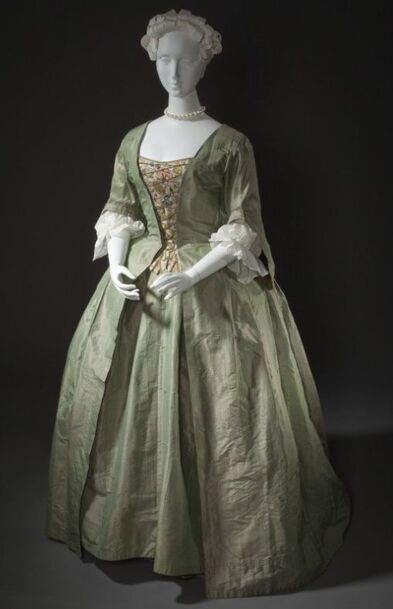|
The subject of lacing in 18th century garments came up in a costume-related online discussion recently, and I thought it was a little corner of costume history interesting enough to delve into in a bit more detail, with a few examples. In this particular discussion, lacing referred to either decorative (or sometimes functional) front lacing on garments, not the lacing closures in stays or other underclothing. There was a variety of lacing on bodices throughout the 18th century, as you might imagine, some of it quite cleverly executed (yes, "Varietie" in the title above is the archaic spelling, just for fun). Generally, but not always, this lacing, if intended to be seen, was done in a criss-cross pattern, in contrast to the spiral lacing typical of stays. I haven't yet found any definitive source(s) for exactly why this was the case, but in many extant garments (e.g. stomachers) where bodice front lacing can still be seen, the lacing is usually criss-crossed, sometimes with a little decorative loop in the middle. In terms of garment construction, I can think of four types of 18th century bodice front lacing -- at least as seen in the few surviving examples documented -- but there are probably more. I'm deliberately leaving out fabric bands, fancy bows (échelles), buckled bands, clasps, and the like (seen in many paintings of the era) that were also used to cross or close the front of bodices, and will be focusing rather on narrower lacing only, i.e. cord-like or fine ribbon lacing. I'm also ignoring jacket front closures, where lacing was likely more common.
Here then are the four types that spring to mind fairly spontaneously from my own recall and experience in research. This, I should point out, is not intended in any way as an exhaustive or conclusive treatment of the subject, but as a brief glimpse of this niche of historical fashion (click on "Read More" to continue):
8 Comments
|
AuthorPatricia Preston, a.k.a. The Fashion Archaeologist, Historian, linguist, pattern-maker, enthralled by historical fashion, especially the 18th, 19th and 20th centuries.. Archives
August 2022
Categories
All
|
Site powered by Weebly. Managed by Dot5Hosting


 RSS Feed
RSS Feed